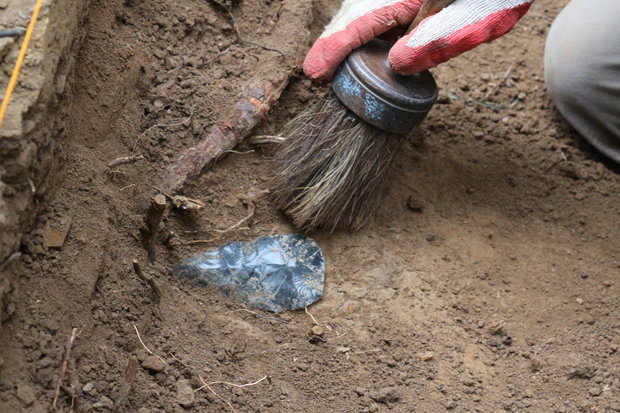
PHOTO: oregonlive.com
WILLAMETTE VALLEY, OREGON – A local landowner struck historical gold while he was building a new pond on his property. His find has been recorded as the first Native American tools of their kind in the Willamette Valley area.
When he found the 15 obsidian axes buried on his property, he immediately alerted the Oregon State Historical Preservation Office. This June, they headed an archaeological dig led by archaeologist John Pouley.
While archaeological sites are hardly uncommon in the state of Oregon (it’s home to over 35,000 recorded sites), this particular find is unique. The axes are bifaces, a term that means the tools’ creators flaked them on both sides of the stone. Out of the thousands of historical sites, less than 25 have biface caches.
Archaeologists think the tools range from 1,000 to 4,000 years old. Since they were found in between Portland and Roseberg, they most likely belonged to the Santiam Band of the Kalapuya, who made their home along that stretch of land in Western Oregon.
The Kalapuyas and Trade in the Northwest
The Kalapuya lived in the heart of the Willamette Valley, just between the Coastal Range Mountains and the Cascades. They were a semi-nomadic people, and traded regularly with the Molalla and Cayuse and some tribes from Northern California, the Oregon Coast, and the Colombia River tribes.
The Kalapuya migrated throughout the Northwest during the winter months, and would have had contact with tribes from all over Oregon.
Archaeologists believe this cache of biface weapons is vital in better understanding the trade relationship between the Oregonian tribes. They’ve called for help from the Confederated Tribes of the Grand Ronde, the Confederated Tribes of the Siletz, and the Confederated Tribes of the Warm Springs Reservation to better understand and interpret the find. They believe it’s extremely important to keep a working relationship with the native tribes of the area. The history and archaeology of the Northwest is best understood by the indigenous people groups who have always lived there. It’s their history, after all.
With their help, the archaeologists have figured out that the obsidian the tools were made from most likely came from the Obsidian Cliffs miles away in the Central Oregon Cascades. Perhaps the Kalapuya traded some valuable Willamette Valley furs for the obsidian, and from there they worked them into tools. Or, more likely, the tools were first created at the Obsidian Cliffs.
Since the tools from the find were unfinished, archaeologists think they were used for bartering in trades before finally being turned into finished tools. They’re hoping that, as they excavate more, the find will help historians and experts better understand early Native American trade routes in the Pacific Northwest.
Currently, the find is being cataloged and taken care of by the Oregon State Historical Preservation Office. Pouley will draw up a report about the tools once excavation at the Oregonian landowner’s property is complete. He and his team of archaeologists will present their findings and new theories at an anthropological conference being held in Spokane, Washington next year.
As the tools are being taken care of, reports are being formed, and the history is being added to, Pouley wants the public to remember the importance of reporting any archaeological finds made on personal property. None of this would have been possible without the landowner realizing what he’d found and taking the initiative to call the Historical Preservation Office.
“This site makes you wonder how many archaeological sites with the potential to shed light on the history of human occupation within Oregon have been found before, and never reported. We encourage anyone that finds artifacts on their property to contact us.”
– John Pouley

